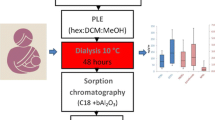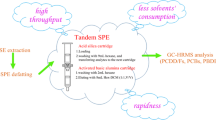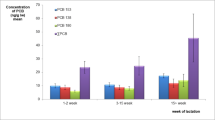Abstract
Bisphenol A (BPA) is an industrial chemical widely used in the production of polycarbonate and epoxy resins. Identified as an endocrine-disrupting chemical (EDC), BPA is a matter of existing or ongoing restrictive regulations and then is increasingly being replaced by other analogues used as BPA’s substitutes. Human biomonitoring studies focusing on both BPA and emerging related analogues consequently appear as a requirement either for documenting the efficiency of regulatory actions toward BPA and for fuelling incoming risk assessment studies toward BPA’s substitutes. In particular, the increasing concern about the late effects consecutive to early exposures naturally identify human breast milk as a target biological matrix of interest for priority exposure assessment focused on critical sub-populations such as pregnant women, fetuses, and/or newborns. In this context, an accurate and sensitive analytical method based on gas chromatography coupled to tandem mass spectrometry (GC-MS/MS) was developed for the quantification of 18 “BPA-like” compounds in breast milk samples at trace levels (<0.05 μg kg−1). The method includes a preliminary protein precipitation step followed by two successive solid-phase extraction (SPE) stages. Quantification of the targeted compounds was achieved according to the isotopic dilution method using 13C12-BPA as internal standard. The method was validated according to current EU guidelines and criteria. Linearity (R 2) was better than 0.99 for each molecule within the concentration range 0–5 μg kg−1. The detection and quantification limits ranged from 0.001 to 0.030 μg kg−1 and from 0.002 to 0.050 μg kg−1, respectively. The analytical method was successfully applied to the first set of human breast milk samples (n = 30) originating from French women in the Region Pays-de-la-Loire. The measured levels of BPA were found in the <LOQ–1.16 μg kg−1 range. BPS was detected in only one sample at 0.23 μg kg−1, while the other targeted molecules were not detected. The proposed methodology then appeared suitable for the further monitoring of a potential decrease of BPA levels and an increase of other BPA analogue levels as reflective of the expected incoming trend in terms of human exposure.

Analytical strategy for the determination of bisphenol compounds in human breast milk samples





Similar content being viewed by others
References
European Commission, Off. J. Eur. Commun. L12 (2011)1
Opinion of the Scientific Committee on food on bisphenol A, European Commission, Brussels, 2002, available online: http://ec.europa.eu/food/fs/sc/scf/out128_en.pdf
Opinion of the Scientific Panel on Food Additives, adopted on November 2006. The EFSA journal 428 (2006)1, available online: http://www.efsa.europa.eu/en/scdocs/doc/s428.pdf
European Commission, amending Directive 2002/72/EC as regards the restriction of use of bisphenol A in plastic infant feeding bottles, Off. J. Eur. L26 (2011)11
The French Law No 2012-1442 of 24 December 2012 for the suspension of the manufacture import, export and marketing of all-purpose food packaging containing bisphenol A. (2012). Official Journal of the French Republic
Chen MY, Ike M, Fujita M (2002) Acute toxicity, mutagenicity, and estrogenicity of bisphenol-A and other bisphenols. Environ Toxicol 17(1):80–86
Kitamura S, Suzuki T, Sanoh S, Kohta R, Jinno N, Sugihara K, Yoshihara S, Fujimoto N, Watanabe H, Ohta S (2005) Comparative study of the endocrine-disrupting activity of bisphenol A and 19 related compounds. Toxicol Sci Off J Soc Toxicol 84(2):249–259. doi:10.1093/toxsci/kfi074
Vandenberg LN, Chahoud I, Heindel JJ, Padmanabhan V, Paumgartten FJ, Schoenfelder G (2010) Urinary, circulating, and tissue biomonitoring studies indicate widespread exposure to bisphenol A. Environ Health Perspect 118(8):1055–1070. doi:10.1289/ehp.0901716
Yang Y, Yin J, Zhou N, Zhang J, Shao B, Wu Y (2012) Determination of bisphenol AF (BPAF) in tissues, serum, urine and feces of orally dosed rats by ultra-high-pressure liquid chromatography-electrospray tandem mass spectrometry. J Chromatogr B Anal Technol Biomed Life Sci 901:93–97. doi:10.1016/j.jchromb.2012.06.005
Cunha SC, Fernandes JO (2010) Quantification of free and total bisphenol A and bisphenol B in human urine by dispersive liquid-liquid microextraction (DLLME) and heart-cutting multidimensional gas chromatography-mass spectrometry (MD-GC/MS). Talanta 83(1):117–125. doi:10.1016/j.talanta.2010.08.048
Liao C, Liu F, Alomirah H, Loi VD, Mohd MA, Moon HB, Nakata H, Kannan K (2012) Bisphenol S in urine from the United States and seven Asian countries: occurrence and human exposures. Environ Sci Technol 46(12):6860–6866. doi:10.1021/es301334j
Zhou X, Kramer JP, Calafat AM, Ye X (2014) Automated on-line column-switching high performance liquid chromatography isotope dilution tandem mass spectrometry method for the quantification of bisphenol A, bisphenol F, bisphenol S, and 11 other phenols in urine. J Chromatogr B Anal Technol Biomed Life Sci 944:152–156. doi:10.1016/j.jchromb.2013.11.009
Vela-Soria F, Ballesteros O, Zafra-Gomez A, Ballesteros L, Navalon A (2014) UHPLC-MS/MS method for the determination of bisphenol A and its chlorinated derivatives, bisphenol S, parabens, and benzophenones in human urine samples. Anal Bioanal Chem 406(15):3773–3785. doi:10.1007/s00216-014-7785-9
Kuruto-Niwa R, Tateoka Y, Usuki Y, Nozawa R (2007) Measurement of bisphenol A concentrations in human colostrum. Chemosphere 66(6):1160–1164. doi:10.1016/j.chemosphere.2006.06.073
Sun Y, Irie M, Kishikawa N, Wada M, Kuroda N, Nakashima K (2004) Determination of bisphenol A in human breast milk by HPLC with column-switching and fluorescence detection. Biomed Chromatogr BMC 18(8):501–507. doi:10.1002/bmc.345
Yi B, Kim C, Yang M (2010) Biological monitoring of bisphenol A with HLPC/FLD and LC/MS/MS assays. J Chromatogr B Anal Technol Biomed Life Sci 878(27):2606–2610. doi:10.1016/j.jchromb.2010.02.008
Ye X, Kuklenyik Z, Needham LL, Calafat AM (2006) Measuring environmental phenols and chlorinated organic chemicals in breast milk using automated on-line column-switching-high performance liquid chromatography-isotope dilution tandem mass spectrometry. J Chromatogr B Anal Technol Biomed Life Sci 831(1–2):110–115. doi:10.1016/j.jchromb.2005.11.050
Cariot A, Dupuis A, Albouy-Llaty M, Legube B, Rabouan S, Migeot V (2012) Reliable quantification of bisphenol A and its chlorinated derivatives in human breast milk using UPLC-MS/MS method. Talanta 100:175–182. doi:10.1016/j.talanta.2012.08.034
Zimmers SM, Browne EP, O'Keefe PW, Anderton DL, Kramer L, Reckhow DA, Arcaro KF (2014) Determination of free bisphenol A (BPA) concentrations in breast milk of U.S. women using a sensitive LC/MS/MS method. Chemosphere 104:237–243. doi:10.1016/j.chemosphere.2013.12.085
Samanidou VFF,MA, Papadoyannis IN (2014) Matrix solid phase dispersion for the extraction of bisphenol A from human breast milk prior to HPLC analysis. Liq Chromatogr Relat Technol 37:247
Otaka H, Yasuhara A, Morita M (2003) Determination of bisphenol A and 4-nonylphenol in human milk using alkaline digestion and cleanup by solid-phase extraction. Anal Sci Int J Jpn Soc Anal Chem 19(12):1663–1666
Migeot V, Dupuis A, Cariot A, Albouy-Llaty M, Pierre F, Rabouan S (2013) Bisphenol a and its chlorinated derivatives in human colostrum. Environ Sci Technol 47(23):13791–13797. doi:10.1021/es403071a
Rodriguez-Gomez R, Zafra-Gomez A, Camino-Sanchez FJ, Ballesteros O, Navalon A (2014) Gas chromatography and ultra high performance liquid chromatography tandem mass spectrometry methods for the determination of selected endocrine disrupting chemicals in human breast milk after stir-bar sorptive extraction. J Chromatogr A 1349:69–79. doi:10.1016/j.chroma.2014.04.100
Deceuninck Y, Bichon E, Durand S, Bemrah N, Zendong Z, Morvan ML, Marchand P, Dervilly-Pinel G, Antignac JP, Leblanc JC, Le Bizec B (2014) Development and validation of a specific and sensitive gas chromatography tandem mass spectrometry method for the determination of bisphenol A residues in a large set of food items. J Chromatogr A 1362:241–249. doi:10.1016/j.chroma.2014.07.105
Ye X, Zhou X, Hennings R, Kramer J, Calafat AM (2013) Potential external contamination with bisphenol A and other ubiquitous organic environmental chemicals during biomonitoring analysis: an elusive laboratory challenge. Environ Health Perspect 121(3):283–286. doi:10.1289/ehp.1206093
Acknowledgments
The authors are first of all very grateful to all volunteer women included in the present study from which the analyzed breast milk samples were collected. They thank the Region Pays-de-Loire, the Fond Européen de Développement Economique et Régional (FEDER, Grant 38395, Project 6226 « Lactacol »), and the Agence Nationale de la Recherche (ANR-13-CESA-0012-01 “Newplast”) for funding support. They thank the Clinical Investigation Center (CIC) from the Nantes University Hospital and also Hélène Billard (INRA PHAN) for having collected the samples.
Author information
Authors and Affiliations
Corresponding author
Rights and permissions
About this article
Cite this article
Deceuninck, Y., Bichon, E., Marchand, P. et al. Determination of bisphenol A and related substitutes/analogues in human breast milk using gas chromatography-tandem mass spectrometry. Anal Bioanal Chem 407, 2485–2497 (2015). https://doi.org/10.1007/s00216-015-8469-9
Received:
Revised:
Accepted:
Published:
Issue Date:
DOI: https://doi.org/10.1007/s00216-015-8469-9




